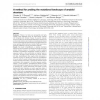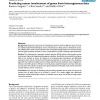294 search results - page 26 / 59 » Predicting the beta-helix fold from protein sequence data |
KDD
2001
ACM
14 years 8 months ago
2001
ACM
During the last decade, the area of bioinformatics has produced an overwhelming amount of data, with the recently published draft of the human genome being the most prominent exam...
BIOINFORMATICS
2011
12 years 11 months ago
2011
Motivation: Proteins of all kinds can self-assemble into highly ordered β-sheet aggregates known as amyloid fibrils, important both biologically and clinically. However, the spe...
JCB
2007
13 years 7 months ago
2007
MicroRNAs (miRNAs) regulate a large proportion of mammalian genes by hybridizing to targeted messenger RNAs (mRNAs) and down-regulating their translation into protein. Although mu...
BMCBI
2006
13 years 7 months ago
2006
Background: Prediction of human cell response to anti-cancer drugs (compounds) from microarray data is a challenging problem, due to the noise properties of microarrays as well as...
BMCBI
2008
13 years 7 months ago
2008
Background: Systematic approaches for identifying proteins involved in different types of cancer are needed. Experimental techniques such as microarrays are being used to characte...


